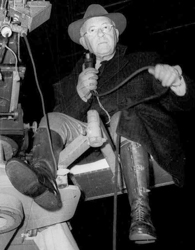Cecil B. DeMille was one of the most successful directors in Hollywood. Not only did he produce and direct more than 70 films to earn a substantial profit, but he is frequently credited with turning Hollywood into the “motion picture capital of the world.”
Cecil DeMille’s Early Days
Cecil Blount de Mille was born on August 12, 1881, to Henry Churchill de Mille, a Columbia University teacher and wannabe actor, and Matilda Beatrice Samuel de Mille. In his personal life, Cecil spelled his last name like the rest of his family, but in his professional life opted for “DeMille.”
Cecil attended Pennsylvania Military College, as well as the American Academy of Dramatic Arts. He made his first appearance on stage in February 1900. While working as an actor, stage manager and director, Cecil also helped his mother manage an agency for plays and playwrights that she started after her husband died.
In 1913, DeMille, Jesse L. Lasky and Samuel Goldwyn created the Lasky Film Company, which later became Paramount Pictures. The group’s first project was “The Squaw Man,” which DeMille co-wrote, co-directed and co-produced with the help of Oscar Apfel. It was this experience that launched DeMille on a decades-long love affair with filmmaking.
In 1914, Cecil’s brother William sent him a letter pleading with him to leave the filmmaking industry. “I did not realize you had reached the stage of utter desperation,” William said. “After all you do come of a cultured family. I cannot understand how you are willing to identify yourself with a cheap form of amusement and which no one will ever allude to as art.” A few months later, William sent Cecil another letter asking for a job.
Sources in this Story
- The Official Web Site of Cecil B. DeMille: Biography
- The AllMovie Guide: Cecil B. Demille
- The Daily Telegraph: The epic life of Cecil B. DeMille
- The Biography Channel: Cecil B. De Mille Biography
- The New York Times: Cecil De Mille, 77, Pioneer of Movies, Dead in Hollywood
- UCLA Film and Television Archive: “Cecil B. DeMille”
- Hollywood Foreign Press Association: The Cecil B. DeMille Award
- Time: Epic-Maker
DeMille’s Filmmaking Career
DeMille sought to “give the public what it wants” in his films. Profits made from his films proved that DeMille’s theory was correct; he was one of the most successful directors in Hollywood.
DeMille was a pioneer in special effects, beginning with his 1932 biblical epic “The Ten Commandments,” in which he and his special effects team were able to recreate the parting of the Red Sea using two mounds of gelatin.
“DeMille believed that the spectacular added to the box office value of his pictures,” said film historian Bob Birchard to The Biography Channel. “The parting of the Red Sea is a perfect example, this huge spectacle, something unlike anybody had ever seen.”
Costing an unprecedented $1.4 million, “The Ten Commandments” made a large profit. “From that time on,” says The New York Times, “Mr. De Mille wallowed in extravagant props and super-gorgeous sets. It was a good formula. It worked in ‘The Crusades,’ ‘The Sign of the Cross,’ ‘King of Kings,’ ‘Cleopatra’ and a long list of other De Mille spectaculars.”
DeMille himself was as distinctive as his films, constructing an eccentric persona made him famous. He was known for, among other things, ordering a crewmember to follow him at all times with a chair behind him and for carrying a pistol around the set. He was also the first director to use a megaphone and to install a loudspeaker on set.
He was a “consummate showman,” describes the UCLA Film and Television Archive, “who knew better than anyone how to promote his films and himself.” He made star out of many actors and actresses, such as Gloria Swanson, who uttered the now-immortal line, “All right, Mr. DeMille, I’m ready for my close-up,” in Billy Wilder’s “Sunset Boulevard.”
Late in his career, in 1953, DeMille won his only Oscar for his circus-themed film, “The Greatest Show on Earth.” His final film was a remake of “The Ten Commandments,” which ranks as one his greatest achievements. When the time came to promote the movie, DeMille supported an idea to place etched granite replicas of the Ten Commandments in parks and on courthouse and capital lawns.
The Rest of the Story
Among the honors bestowed to DeMille in his lifetime was the naming of the Golden Globe’s lifetime achievement award after him. DeMille himself received the first Cecil B. DeMille award in 1952 for his work on “The Greatest Show on Earth.”
DeMille died of a heart attack on January 21, 1959. Hollywood treated his death “with uncommon dignity,” wrote Time magazine. “Only a handful of mourners were at his grave. It was a modest exit for a showman whose 70 pictures have made more money than any other movies ever filmed.”











